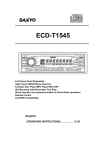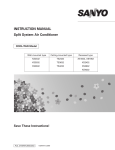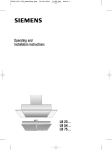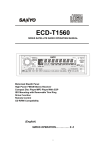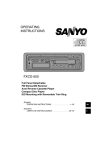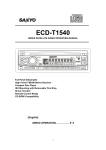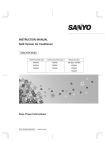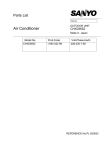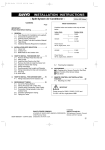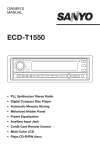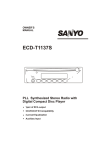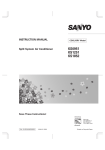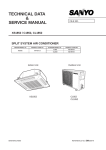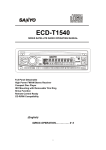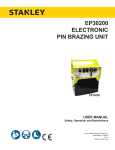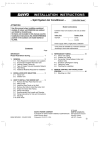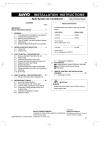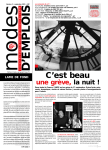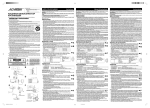Download Sanyo PNR-XS2432 User's Manual
Transcript
INSTALLATION INSTRUCTIONS — Split System Air Conditioner — CONTENTS IMPORTANT Please Read Before Starting Model Combinations Page Combine indoor and outdoor units only as listed below. Indoor units XS1852 (PNR-XS2432) 1. GENERAL ............................................................. 3 1-1. Tools Required for Installation (not supplied) 1-2. Accessories Supplied with Unit 1-3. Optional Copper Tubing Kit 1-4. Type of Copper Tube and Insulation Material 1-5. Additional Materials Required for Installation 1-6. Operating Range 1-7. Tubing Length Power Supply : 60Hz, single-phase, 208/230 V Units should be installed by licensed contractor according to local code requirements 2. SELECTING THE INSTALLATION SITE ............ 5 Indoor Unit Outdoor Unit 2-1. Baffle Plates for the Outdoor Unit 7. HOW TO PROCESS TUBING ........................... 21 7-1. Use of the Flaring Method 7-2. Flaring Procedure with a Flare Tool 7-3. Precaution before Connecting Tubes Tightly 7-4. Precautions during Brazing 7-5. Connecting Tubing between Indoor and Outdoor Units 7-6. Insulating the Refrigerant Tubing 7-7. Taping the Tubes 7-8. Finishing the Installation 3. HOW TO INSTALL THE INDOOR UNIT .............. 7 3-1. 3-2. 3-3. 3-4. 3-5. Outdoor units C1852, CL1852 Suspending the Indoor Unit Preparation for Suspending Placing the Unit Inside the Ceiling Installing the Drain Piping Checking the Drainage 8. AIR PURGING .................................................... 24 ■ Air Purging with a Vacuum Pump (for Test Run) ■ Ceiling Panel ...................................................... 11 3-6. Before Installing the Ceiling Panel 3-7. Installing the Ceiling Panel 3-8. When Removing the Ceiling Panel for Servicing 3-9. Duct for Fresh Air 9. TEST RUN .......................................................... 26 9-1. Performing Test Run 9-2. Performing Test Run with Optional Wired Remote Control Unit 9-3. Basic Function of the Service Valves 9-4. Pump Down 4. HOW TO INSTALL THE REMOTE CONTROL UNIT ................................................. 15 ■ Wireless Remote Control Unit 4-1. Mounting on a Wall ■ Wired Remote Control Unit (Option) 4-2. Installing the Wired Remote Control Unit 5. ADDRESS SWITCHES ....................................... 17 5-1. Finding the Address Switches 5-2. Switch Positions for 2 Units or 2 Groups of Units 6. ELECTRICAL WIRING ....................................... 18 6-1. General Precautions on Wiring 6-2. Recommended Wire Length and Wire Diameter for Power Supply System 6-3. Wiring Instructions for the Outdoor Unit 6-4. Examples of Incorrect Wiring 6-5. How to Connect Wiring to the Terminal 85464359128000 SANYO 2000 1 S4359128 SANYO FISHER COMPANY A DIVISION OF SANYO NORTH AMERICA CORPORATION 21605 Plummer Street Chatsworth, CA91311 Important IMPORTANT! Please Read Before Starting When Transporting …………………………………………………………………… Be careful when picking up and moving the indoor and outdoor units. Get a partner to help, and bend your knees when lifting to reduce strain on your back. Sharp edges or thin aluminum fins on the air conditioner can cut your fingers. This air conditioning system meets strict safety and operating standards. As the installer or service person, it is an important part of your job to install or service the system so it operates safely and efficiently. For safe installation and trouble-free operation,you must: When Installing …………………………………………………………………… ⓦ Carefully read this instruction booklet before beginning. …In a Room Properly insulate any tubing run inside a room to prevent “sweating” that can cause dripping and water damage to walls and floors. ⓦ Follow each installation or repair step exactly as shown. ⓦ Observe all local, state, and national electrical codes. ⓦ Pay close attention to all warning and caution notices given in this manual. …In Moist or Uneven Locations Use a raised concrete pad or concrete blocks to provide a solid, level foundation for the outdoor unit. This prevents water damage and abnormal vibration. This symbol refers to a hazard or unsafe practice which can result in severe personal injury or death. CAUTION …In an area with High Winds Securely anchor the outdoor unit down with bolts and a metal frame. Provide a suitable air baffle. This symbol refers to a hazard or unsafe practice which can result in personal injury or product or property damage. …In a Snowy Area (for Heat Pump-type Systems) If Necessary, Get Help Install the outdoor unit on a raised platform that is higher than drifting snow. Provide snow vents. These instructions are all you need for most installation sites and maintenance conditions. If you require help for a special problem, contact our sales/service outlet or your certified dealer for additional instructions. When Connecting Refrigerant Tubing …………………………………………………………………… • Execute enough ventilation in case refrigerant gases leak during operations. Be careful that the contact of the refrigerant gases with the flare will cause the generation of poisonous gases. In Case of Improper Installation The manufacturer shall in no way be responsible for improper installation or maintenance service, including failure to follow the instructions in this document. • Keep all tubing runs as short as possible. SPECIAL PRECAUTIONS • Use the flare method for connecting tubing. When Wiring …………………………………………………………………… • Apply refrigerant lubricant to the matching surfaces of the flare and union tubes before connecting them, then tighten the nut with a torque wrench for a leak-free connection. ELECTRICAL SHOCK CAN CAUSE SEVERE PERSONAL INJURY OR DEATH. ONLY A QUALIFIED, EXPERIENCED ELECTRICIAN SHOULD ATTEMPT TO WIRE THIS SYSTEM. • Check carefully for leaks before starting the test run. NOTE • Do not supply power to the unit until all wiring and tubing are completed or reconnected and checked. Depending on the system type, liquid and gas lines may be either narrow or wide. Therefore, to avoid confusion the refrigerant tubing for your particular model is specified as either “narrow” or “wide” rather than as “liquid” or “gas”. • Highly dangerous electrical voltages are used in this system. Carefully refer to the wiring diagram and these instructions when wiring. Improper connections and inadequate grounding can cause accidental injury or death. When Servicing …………………………………………………………………… • Turn the power OFF at the main power box (mains) before opening the unit to check or repair electrical parts and wiring. • Ground the unit following local electrical codes. • Connect all wiring tightly. Loose wiring may cause overheating at connection points and a possible fire hazard. • Keep your fingers and clothing away from any moving parts. • Clean up the site after you finish, remembering to check that no metal scraps or bits of wiring have been left inside the unit being serviced. 2 S4359128 1. General Part Name This booklet briefly outlines where and how to install the air conditioning system. Please read over the entire set of instructions for the indoor and outdoor units and make sure all accessory parts listed are with the system before beginning. Figure Wireless remote control unit AAA alkaline battery 1 2 Special screw 4 ✕ 16 mm Tapping screw 1-1. Tools Required for Installation (not supplied) 1. Standard screwdriver 2. Phillips head screwdriver 3. Knife or wire stripper 4. Tape measure 5. Level 6. Sabre saw or key hole saw 7. Hacksaw 8. Core bits 9. Hammer 10. Drill 11. Tube cutter 12. Tube flaring tool 13. Torque wrench 14. Adjustable wrench 15. Reamer (for deburring) 16. Service valve wrench 17. Wire cutter Tapping screw Q’ty 1 1 For wide tubes Installation gauge 1 For adjusting the unit position Insulating tape 1 For wide tube flare nuts Hose band 2 For securing drain hose Packing 1 For drain joint Drain insulator 1 For drain joint Drain hose 1 Drain hose adapter 1 (White for insulating) Owner’s manual Hexagonal Wrench* 1 1-4. Type of Copper Tube and Insulation Material If you wish to purchase these materials separately from a local source, you will need: 1. Deoxidized annealed copper tube for refrigerant tubing. Cut each tube 12 in. to 16 in. longer than the appropriate lengths to dampen vibration between units. 2. Foamed polyethylene insulation for 5/8" (15.88 mm) O.D. copper tubes as required to precise length of tubing. Wall thickness of the insulation should be not less than 0.3 inch (8 mm). Remarks For determining suspension bolt pitch Flare insulator TOTA 4 ✕ 16 Copper tubing for connecting the outdoor unit to the indoor unit is available in kits which contain the narrow and wide tubing, fittings and insulation. Consult your nearest sales outlet or A/C workshop. Table 1-1 Figure 1 1-3. Optional Copper Tubing Kit 1-2. Accessories Supplied with Unit Part Name Full-scale installation diagram Q’ty Check local electrical codes and regulations before obtaining wire. Also, check any specified instructions or limitations. CAUTION 1-5. Additional Materials Required for Installation 1. 2. 3. 4. 5. Insulated staples or clamps for connecting wire (See your local codes.) Putty Refrigeration tubing lubricant Clamps or saddles to secure refrigerant tubing Scale for weighing 1-6. Operating Range For drain outlet Temperature Indoor Air Intake Cooling 1 1 Maximum 95°F DB, 71°F WB Minimum 67°F DB, 57°F WB Outdoor Air Intake 115°F DB 67°F DB (0°F DB)* *CL&&&& Models To open and shut the Narrow Tube Service Valve *Packed in the outdoor unit 3 S4359128 1-7. Tubing Length ● Refrigerant tubing between the indoor and outdoor units should be kept as short as possible. Tubing length (L) INDOOR UNIT ● Select and decide the installation location so that the length of the refrigerant tubing will be within the limits given in Table 1-2. Elevation difference (H) OUTDOOR UNIT 0711_M_I Fig. 1-1 Table 1-2 Models C1852 CL1852 Tubing Data Tubing size outer dia. Narrow tube in. (mm) 1/4 (6.35) : Thickness 0.0314" (0.8 mm) Wide tube in. (mm) 5/8 (15.88) : Thickness 0.0394" (1.0 mm) Limit of tubing length Limit of elevation difference between the 2 units than indoor unit (ft.) 65 Outdoor unit is higher than indoor unit (ft.) 23 Outdoor unit is lower (ft.) 23 Max. allowable tubing length at shipment (ft.) Required additional refrigerant *1 33 (oz./ft.) 0.27 No additional charge of compressor oil is necessary. *1 If total tubing length becomes 33 to 65 ft., charge additional refrigerant (R22) by 0.27 oz./ft.. 4 S4359128 2. Selecting the Installation Site Indoor Unit AVOID: ● areas where leakage of flammable gas may be expected. ● places where large amount of oil mist exist. ● direct sunlight. ● locations near heat sources which may affect performance of the unit. ● locations where external air may enter the room directly. This may cause “sweating” on the air discharge ports, causing them to spray or drip. ● locations where the remote control unit will be splashed with water or affected by dampness or humidity. ● installing the remote control unit behind curtains or furniture. ● locations where the receiver in the indoor unit is exposed to the inverter lamp light. Faulty operation of the unit occurs. DO: 3 ft. ● select an appropriate position from which every corner of the room can be uniformly cooled. ● select a location where the ceiling is strong enough to support the weight of the unit. 3 ft. 3 ft. 3 ft. 3 ft. ● select a location where tubing and drain pipe have the shortest run to the outdoor unit. 1330_X_S ● allow room for operation and maintenance as well as unrestricted air flow around the unit. (Fig. 2-1) Fig. 2-1 ● install the unit within the maximum elevation difference above or below the outdoor unit and within a total tubing length from the outdoor unit as detailed in Table 1-2. ● allow room for mounting the remote control unit about 3 ft. off the floor, in an area that is not in direct sunlight nor in the flow of cool air from the indoor unit. NOTE Air delivery will be degraded if the distance from the floor to the ceiling is greater than 10 ft.. 5 S4359128 Outdoor Unit NO Exhaust fan Hot air AVOID: Heat source ● heat sources, exhaust fans, etc. (Fig. 2-2) Outdoor unit ● damp, humid or uneven locations. DO: 1817_C_I ● choose a place as cool as possible. Fig. 2-2 ● choose a place that is well ventilated. Obstacle above CAUTION Min. 6" (15 cm) ● Do not place objects on or sit on the outdoor unit. Also, never block the air intake/outlet or exhaust. Distortion of the outdoor unit or incomplete combustion may result. Min. 6" Air discharge (15 cm) Valve side Min. 10" (25 cm) Obstacle Air intake ● Install the outdoor unit above snowfall line. Min. Min. 7 ft. 7 ft. (2 m) (2 m) Air discharge ● allow enough room around the unit for air intake/ exhaust and possible maintenance. (Fig. 2-3) Min. 12" (30 cm) 1818_M_I Ground Min. 6 in. (15 cm) Air intake ● Do not introduce foreign matter into the air intake/outlet or exhaust. Do not poke them with such objects as a stick. 1819_M_I Fig. 2-3 Anchor bolts (4 pcs) ● provide a solid base (level concrete pad, concrete block, 4 in. × 16 in. (10 × 40 cm) beams or equal), a minimum of 4 in. (10 cm) above ground level to reduce humidity and protect the unit against possible water damage and decreased service life (Fig. 2-4). Min. 4" (10 cm) Air intake Concrete or equal ● use lug bolts or equal to bolt down unit, reducing vibration and noise. Ab ou t1 2-1. Baffle Plates for the Outdoor Unit (CL×× models only) 6" Abou (40 t 4" ( 10 c m) cm ) 1820_M_I Fig. 2-4 When the outdoor unit is installed in a position exposed to strong wind (like seasonal winds with low air temperature in winter), baffle plates must be installed on the outdoor unit. (Fig. 2-5) 6" min Baffle plate Baffle plate Air discharge This unit is designed so that the fan of the outdoor unit runs at low speed when the air conditioner is operated at low outdoor air temperatures. When the outdoor unit is exposed to strong wind, the system pressure drops because of the freeze protector. 6 6" min Air discharge NOTE It is recommended to use baffle plates for model CL1852. The baffle plates are not normally required for the other models. 1821_M_I Fig. 2-5 S4359128 3. How to Install the Indoor Unit 3-1. Suspending the Indoor Unit This unit uses a drain pump. Use a carpenter’s level to check that the unit is level. 3-2. Preparation for Suspending (1) Fix the suspension bolts securely in the ceiling using the method shown in the diagrams (Figs. 3-1 and 3-2), by attaching them to the ceiling support structure, or by any other method that ensures that the unit will be securely and safely suspended. (2) Follow Fig. 3-2 and Table 3-1 to make the holes in the ceiling. Hole-in-anchor Hole-in-plug Concrete Insert Suspension bolt (M10 or 3/8") (field supply) 0038_T_I Fig. 3-1 A 1/2" (3) 820 (ceiling opening dimension) XS1852 (PNR-XS2432) 32-9/32 (820) 28-3/4 (730) B (suspension bolt pitch) 1/2" 1/2" Length Refrigerant tubing side Drain hose side 1/2" Type A (ceiling opening dimension) Unit : inch (mm) B 590 (suspension bolt pitch) Table 3-1 Determine the pitch of the suspension bolts using the supplied full-scale installation diagram. The diagram and table (Fig. 3-3 and Table 3-2) show the relationship between the positions of the suspension fitting, the unit, and the panel. Unit: inch Fig. 3-2 0962_S_I Refrigerant tubing joint (narrow tube side) Refrigerant tubing joint (wide tube side) Drain inspection port E A B C D Suspension lug 15/32" 15/32" Power supply inlet Fig. 3-3 Table 3-2 Type Length A XS1852 (PNR-XS2432) 5-29/32 B 7-7/8 C D Unit : inch E 10-1/32 11-23/32 4-29/32 7 S4359128 1019_X_I 3-3. Placing the Unit Inside the Ceiling (2) (3) When placing the unit inside the ceiling, determine the pitch of the suspension bolts using the supplied full-scale installation diagram. (Fig. 3-4) The size of the opening for the indoor unit can be confirmed by attaching the full-scale installation diagram beneath the unit. (Fig. 3-4) Tubing and wiring must be laid inside the ceiling when suspending the unit. If the ceiling is already constructed, lay the tubing and wiring into position for connection to the unit before placing the unit inside the ceiling. More than 2-3/8 inch Full-scale installation diagram (printed on a cardboard packing) 1-7/8 inch (1) Full-scale installation diagram 0963_X_I Fig. 3-4 The length of suspension bolt must be appropriate for a distance between the bottom of the bolt and the bottom of the ceiling of more than 2-3/8 in. as shown in Fig. 3-4. Suspension bolt Suspension lug Nuts and washers (2 sets) Thread the 2 hexagonal nuts and washers (field supply) onto the 4 suspension bolts as shown in Fig. 3-5. Upper Lower Use 2 sets of nuts and washers (upper and lower), so that the unit will not fall off the suspension lugs. (4) Remove the protective cardboard used to protect the fan parts during transport. (5) Adjust the distance between the unit and surface of the ceiling (1-7/8 in.) using the supplied installation gauge. (Fig. 3-4) 0041_X_I Fig. 3-5 8 S4359128 3-4. Installing the Drain Piping (1) Transparent part for checking drainage Prepare standard hard PVC pipe (O.D. 1-3/64 in.) for the drain and use the supplied drain hose and hose band to prevent water leaks. The PVC pipe must be purchased separately. The transparent part allows you to check drainage. (Fig. 3-6) CAUTION (2) Packing (supplied) Tighten the hose clamps so their locking nuts face upward. (Fig. 3-6) Drain hose (supplied) Hard PVC pipe (not supplied) Drain hose adapter (supplied) 0964_X_I Fig. 3-6 Drain insulator (supplied) After checking the drainage, wrap the supplied packing and drain pipe insulator around the pipe. (Fig. 3-7) NOTE Ensure the drain pipe has a downward gradient (1/100 or more) and that there are no water traps. Fig. 3-7 ● Do not install an air CAUTION Hose band (supplied) 0197_X_I Air bleeder bleeder tubes, as this may cause water to spray from the drain tube outlet. (Fig. 3-8) 0047_X_I ● If it is necessary to increase the height Fig. 3-8 of the drain pipe, the section directly after the connection port can be raised a maximum of 10 in. Do not raise it any higher than 10 in., as this could result in water leaks. (Fig. 3-9) 5 in. or less (as short as possible) 10 in. or less ● Do not install the pipe with an upward gradient from the connection port. It will cause the drain water to flow backwards and leak when the unit is stopped. (Fig. 3-10) 0965_X_I Fig. 3-9 Upward gradient ● Do not apply force to the piping on the unit side when connecting the drain pipe. The pipe should not be allowed to hang unsupported from its connection to the unit. Fasten the pipe to a wall, frame, or other support as close to the unit as possible. (Fig. 3-11) 0049_X_I Fig. 3-10 ● Provide insulation for any drain pipes that are installed indoors. Support pieces 0050_X_I Fig. 3-11 9 S4359128 3-5. Checking the Drainage After wiring and piping are completed, use the following procedure to check that the water will drain smoothly. For this, prepare a bucket and wiping cloth ready to catch and wipe up spilled water. Do not supply power to the unit until the tubing and wiring to the outdoor unit are completed. (1) Take off the tube cover and through the opening, slowly pour about 43 oz. of water into the drain pan to check drainage. (2) Do Test Run to check the drainage after completing installation. When performing Test Run, be sure to observe the Test Run procedure. Refer to page 37. CAUTION (3) Be careful since the fan will start turning when checking the drainage. 5/16"(4 × 8 mm) tapping screw After drain checking is finished, return the Operation Selector switch to the RUN position (ON position ) and remount the tube cover. CAUTION To mount the tube cover, use 5/16" (4 × 8 mm) tapping screws. Do not use long screws as they may puncture the drain pan and cause water leakage. Tube cover Siphon 0966_X_I Fig. 3-12 10 S4359128 ■ Ceiling Panel CAUTION Never touch or attempt to move the air direction louver by hand or you may damage the unit. Instead, use the remote control unit if you want to change the direction or air flow. 3-6. Before Installing the Ceiling Panel (1) (2) Remove the air-intake grille and air filter from the ceiling panel. (Figs. 3-13 and 3-14) (a) Remove the 2 screws on the latch of the airintake grille. (Fig. 3-13) (b) Press on the 2 latches of the air-intake grille with your thumb in the direction of the arrow to open the grille. (Fig. 3-13) (c) With the air-intake grille open about 45˚, remove the safety string (hook on the grille side). (Fig. 3-14) (d) Pull the air-intake grille towards you to remove it from the ceiling panel. Latch Screw Air intake grille Pull down the two panel catches on the body of the indoor unit body. (Fig. 3-15) Ceiling panel 0149_X_I Fig. 3-13 Air filter 45° Safety string Fig. 3-14 0150_X_I 11 S4359128 3-7. Installing the Ceiling Panel (1) Lift the ceiling panel and position it to align the panel hook with the panel catch of the indoor unit. (5) Install the air filter and air-intake grille by performing the steps in section 3-6 in reverse. NOTE The ceiling panel must be mounted in the correct direction. Note that the 2 catches of the panel differ in size. Confirm that the catches are correctly matched between the ceiling panel and the indoor unit body. NOTE Rehook the safety string before closing the air-intake grille. (2) Next, check to see that the ceiling panel is properly aligned with the seamline of the ceiling. If it is not, remove the ceiling panel and slightly readjust the indoor unit body to the proper suspension point. When removing the ceiling panel for servicing, remove the air-intake grille and air filter, disconnect the wiring connector inside the electrical component box, and then remove the 4 mounting screws. (3) When the ceiling panel has been properly aligned, use the supplied 4 mounting screws (M5) with washers to permanently fasten the ceiling panel. (4) Install the wiring connector from the ceiling panel to the connector in the electrical component box of the indoor unit. After installing the connector, use the clamp on the body of the indoor unit to secure the wiring. 3-8. When Removing the Ceiling Panel for Servicing Panel catch (pull down) Connector on unit (inside electrical component box) Electrical component box Ceiling panel Connector of ceiling panel Unit body Electrical component box Panel catch (pull down) Clamp Ceiling panel wiring connector Ceiling panel Screws M5 with washer Mark Air filter Air-intake grille Fig. 3-15 12 S4359128 0967_X_I 3-9. Duct for Fresh Air ● Air-intake chamber (including Duct connection box and flange) are attached to the indoor unit when used to take fresh outdoor air. High-performance filter or Super long-life filter can be also installed in the air-intake chamber. (1) SETUP PRIOR TO INSTALLATION ● When installing the high performance filter or super long-life filter, the parts and parts numbers of filters to be assembled with the air-intake chamber are listed below. Please check that the correct part numbers are present. Air-intake chamber CMB-GSJ80T (XS1852) High performance filter AFT-MSJ80T AFT-HSJ80T Super long-life filter AFT-LSJ80T (2) ACCESSORIES ● Check that the following parts are in the box when unpacking. QT’Y REMARKS Cord with socket (9P) NAME 1 Connecting line. Connect only when high-performance filter is used Screw (M5 × L125) 4 Air-intake filter (for fastening) Screw (M4 × L12) 4+4 Duct connection flange/ box (for fastening) Duct connection box 1 (for fresh air) Duct connection flange 1 (for connecting fresh air duct) (3) INSTALLATION (a) Setup for the indoor unit ● When assembling the high-performance filter, open the lid of the electrical component box, remove the socket (9P) of the fan motor cable inside the electrical component box and connect the accessory cord with socket (9P). CAUTION Do not connect the “accessory cord with socket” to the electrical component box when the unit is used to take fresh air. Do not connect the “accessory cord with socket” when assembling the super longlife filter. Always store the “accessory cord with socket” inside the electrical component box. Cord with socket (9P) Installation steps (a) to (b) are the same for both the CMB-GSJ80T and the GSJ140T. The drawing illustrates installation of air-intake chamber to the CMB-GSJ80T. Electrical component box 1114_X_S Fig. 3-16 13 S4359128 (b) INSTALLING THE AIR-INTAKE CHAMBER ● Set the air-intake chamber to the indoor unit taking care not to set to the incorrect direction. (Fig. 3-17) ● Fasten the air-intake camber with the accessory screws. (M5 × L125, 4pcs) (Fig. 3-17) Installation screws (c) INSTALLING THE DUCT CONNECTION BOX ● Fasten the duct connection flange to the duct connection box with the accessory screws (M4 × L12, 4 pcs.). (Fig. 3-18) ● Put the duct connction box into the rectangular hole of the air-intake chamber and fasten it to the both sides of the indoor unit and chamber with the accessory screws (M4 × L12, 4 pcs.). (Fig. 3-18) (d) INSTALLING THE INDOOR UNIT ● Install the indoor unit to the ceiling. (Install the indoor unit according to items 3-1 to 3-6.) (e) INSTALLING THE CEILING PANEL ● Attach the ceiling panel to the chamber. ● Remove the socket cover of the air-intake chamber and pass the 3P and 6P sockets through it. (Fig. 3-17) ● Connect the 3P socket to the 3P plug of the indoor unit electrical component box. ● Connect the 6P socket to the 6P plug from the operation selector. ● Reattach the socket cover. Socket cover Air-intake chamber (6P socket) 3P socket (from ceiling panel) 3P plug (electrical component box) Operation selector Indoor unit 6P plug 1115_X_S Fig. 3-17 (f) INSTALLING THE HIGH-PERFORMANCE FILTER OR SUPER LONG-LIFE FILTER (Fig. 3-18) ● Turn the filter hooks of the air-intake chamber. ● Install high-performance or super long-life filter into the chamber. (Install in the correct direction. Set the filter so that the arrow on the side as shown in the drawing on the right can be installed into the air-intake chamber. ● Turn the filter hook (positioned so the filter frame is aligned) and secure the air filter in place. Installation screws (M4 × 12) Arrow Air filter Installation screws (M4 × 12) Duct connection box Duct connection flange Rectangular hole Filter hook Ceiling panel CAUTION Take adequate precautions when installing onto the ceiling. The air-intake chamber is especially prone to rupture if struck on it’s side. 1113_X_S Fig. 3-18 14 S4359128 4. How to Install the Remote Control Unit ■ Wireless Remote Control Unit The remote control unit can be operated from either a non-fixed position or a wall-mounted position. To ensure that the air conditioner operates correctly, do not install the remote control unit in the following places: ● ● ● ● ● ● In direct sunlight Behind a curtain or other place where it is covered More than 26 ft. away from the air conditioner In the path of the air conditioner’s airstream Where it may become extremely hot or cold Where it may be subject to electrical or magnetic interference Removable mounting 4-1. Mounting on a Wall (1) (a) Momentarily hold the remote control unit in the desired mounting position. (b) Confirm that the air conditioner responds correctly when you press keys on the remote control from that position. (c) After confirming correct operation, use a screwdriver to screw the supplied special mounting screw into the wall. (Fig. 4-1) (d) (2) Wall Removable mounting Special mounting screw (Packed in indoor unit) 0532_M_I Fig. 4-1 Hang the remote control unit from the mounting screw. Non-removable mounting (a) (b) Momentarily hold the remote control unit in the desired mounting position. Non-removable mounting Confirm that the air conditioner responds correctly when you press keys on the remote control from that position. (c) After confirming correct operation, use a screwdriver to screw the mounting screw into the wall. (Fig. 4-1) (d) Remove the remote control cover by sliding it downward. (e) Remove the batteries of the remote control unit. (f) Hang the remote control unit from the mounting screw, and use a screwdriver to screw the remote control unit securing screw into the wall through the hole in the battery compartment. (Fig. 4-2) (g) Replace the batteries. (h) Again confirm that the remote control unit operates correctly. Wall Screw (Packed in indoor unit) 0533_M_I Fig. 4-2 15 S4359128 ■ Wired Remote Control Unit (Option) (1) To access the printed circuit board, remove the cover plate of the electrical component box. (2) Attach the remote control connectors securely to the mating connector pins on the printed circuit board. (3) Turn the R.C.U. switch from “WIRELESS” to “WIRED”. (4) Replace the cover plate. Electrical component box Cover plate Do not supply power to the unit until the tubing and wiring to the outdoor unit is completed. The mounting position for the remote control unit should be located in an accessible place for control and permit the average room temperature to be detected. Never cover the unit or recess it into the wall. Connector for the wired remote control unit WIRED WIRELESS R.C.U. Switch 1006_M_I Fig. 4-3 4-2. Installing the Wired Remote Control Unit (1) (2) (3) (4) Use a ballpoint pen or similar pointed object to remove the plastic bushing which is inserted in the rear of the remote control unit. The bushing can be discarded. (Fig. 4-4) Flat-head tapping screw 25/64"(3 × 10 mm) (SATA) Groove Cord Plastic bushing Rear Align the cord with the groove of the remote control unit. Cord clip Ballpoint pen Attach the mounting plate to the wall with the 2 supplied screws. Then align the rail on the rear of the control unit with the slot of the mounting plate and slide the unit down as far as it will go. (Fig. 4-4) Fix the control unit cord to the wall. Remote control unit Remote control unit Mounting plate If local codes allow, the remote control unit cord can be wired in the wall. (Fig. 4-5) Truss-head tapping screw 5/8"(4 × 16 mm) (TOTA) Wall 1020_M_I Fig. 4-4 16 S4359128 0531_M_I Fig. 4-5 5. Address Switches If you are installing one indoor unit or one group of indoor units in the same room, it is necessary for you to assign each unit its own address so that each can be operated by its own remote control unit. You assign the addresses by matching the switch position of each indoor unit with the switch position of its remote control unit. The switch of the remote control unit is shown in Fig. 5-1. 5-1. Finding the Address Switches A B Address Remote Control Unit Remove the lid by sliding it off. You can see the switches inside the battery compartment. (Fig. 5-1) Indoor Unit (1) (2) (3) Address switch is in “A” position at time of shipment. Turn off the Power Switch. Remove the Grille. Remove the cover of the Electrical Component Box. 1008_M_I Fig. 5-1 5-2. Switch Positions for 2 Units or 2 Groups of Units Table 5-1 shows the positions you can use for up to 2 units or 2 groups of indoor units installed in the same room. Two remote control units are necessary to allow the respective units or group to be controlled independently. Table 5-1 Unit No. Remote Control Address switch Indoor Unit Address switch 1 2 1 A OFF OFF 2 B ON ON The indoor unit address switch is set at 1-OFF & 2-OFF position at shipment. NOTE An indoor unit cannot be controlled if its remote control unit is too far away (more than 26 ft.). If the remote control unit does not work correctly, bring it closer to the unit being operated and try again. There should be no obstacles between the remote control unit and the indoor unit. For this reason, if the remote control unit is to be used from a fixed position, check the operation before mounting. P.C.B ON 1 WIRED 2 WIRELESS R.C.U. Switch Address Switch (DSW1) 1321_M_I Fig. 5-2 17 S4359128 6. Electrical Wiring (7) 6-1. General Precautions on Wiring (1) Before wiring, confirm the rated voltage of the unit as shown on its nameplate, then carry out the wiring closely following the wiring diagram. (2) (3) Provide a power outlet to be used exclusively for each unit, and a power supply disconnect and circuit breaker for overcurrent protection should be provided in the exclusive line. Regulations on wire diameters differ from locality to locality. For field wiring rules, please refer to your LOCAL ELECTRICAL CODES (ex. National Electric Code: ANSI/NFPA70) before beginning. You must ensure that installation complies with all relevant rules and regulations. (8) To prevent possible hazards from insulation failure, the unit must be grounded. To prevent malfunction of the air conditioner caused by electrical noise, care must be taken when wiring as follows: ● The inter-unit control wiring and the remote control wiring (option) should be wired apart from the interunit power wiring. (4) Each wiring connection must be done in accordance with the wiring system diagram. Wrong wiring may cause the unit to misoperate or become damaged. (5) Do not allow wiring to touch the refrigerant tubing, compressor, or any moving parts of the fan. (6) Unauthorized changes in the internal wiring can be very dangerous. The manufacturer will accept no responsibility for any damage or misoperation that occurs as a result of such unauthorized changes. 6-2. Recommended Wire Length and Wire Diameter for Power Supply System (A)*1 Power Supply Models (B)*1 Inter-unit Wiring AWG #12 C1852, CL1852 AWG #12 75 ft. 65 ft. Time Delay Power Supply Terminal Base (Outdoor Unit) Fuse or Circuit Max. Wire Capacity Capacity Diameter 15 A 20 A *1 Refer to the Wiring System Diagrams (See Fig. 6-3) for the meaning of “A”, “B”. AWG = American Wire Gauge Lock nut 6-3. Wiring Instructions for the Outdoor Unit AWG #12 Terminal block Access panel (1) To take off the access panel, remove the 4 screws. (See Fig. 6-1) (2) Dismount plugs on the conduit plate. (3) Temporarily mount the conduits on the conduit plate. (4) Properly connect both the power supply and interunit lines to the corresponding terminals on the terminal block. Refer to the wiring diagram in Fig. 6-2 (which also appears on the access panel). Conduit plate Plug Power supply Inter-unit line Fig. 6-1 18 S4359128 1822_M_I INDOOR INDOOR UNIT ● Conduit's trade size for this unit is 1/2". The conduit can be purchased at a hardware store. (5) Ground the unit in accordance with local codes. (6) Be sure to size each wire allowing several inches longer than the required length for wiring. (7) B 230/208 V 1 ● The fuse located in the outdoor unit provides power supply protection and may blow when power is applied if the system has been incorrectly wired. OUTDOOR UNIT (Inter-unit) Power lines 1 230/208 V 2 2 230/208 V 3 Power supply line Single-phase, 230/208 V NOTE Fuse 3 4 Disconnect switch (Field supply) 5 6 A L1 L2 G G Grounding line 1823_M_I Fig. 6-2 Use lock nuts to secure the conduit tubes. ● Be sure to comply with local codes while running the wire from the indoor unit to the outdoor unit (size of wire and wiring method, etc.). ● Every wire must be connected firmly. ● No wire should be allowed to touch refrigerant tubing, the compressor or any moving part. ● To avoid the risk of electric shock, each air conditioner unit must be grounded. CAUTION ● Be sure to connect the power supply line to the outdoor unit as shown in the wiring diagram. The indoor unit draws its power from the outdoor unit. 6-4. Examples of Incorrect Wiring The following are examples of improper wiring that result in system misoperation. You should confirm that you have wired the units correctly before beginning the test run. Problem 1 Problem 2 ● Short circuit will occur after approx. 3 minutes and the power circuit fuse blows. ● Air conditioner will not operate. (A) Disconnect switch (B) Disconnect switch (C) Disconnect switch 1 1 1 1 1 1 2 2 2 2 2 2 3 3 3 3 3 3 G G G G G G Grounding line Indoor unit Outdoor unit Grounding line Indoor unit Outdoor unit 1301_C_I 1302_C_I Problem 3 ● Compressor will not start; only indoor unit will operate. (D) Disconnect switch (E) Disconnect switch 1 1 1 1 2 2 2 2 3 3 3 3 G G Grounding line Outdoor unit Indoor unit G G Grounding line Outdoor unit Indoor unit 1304_C_I 1305_C_I 19 S4359128 Grounding line Indoor unit Outdoor unit 1303_C_I Loose wiring may cause the terminal to overheat or result in unit malfunction. A fire hazard may also exist. Therefore, ensure that all wiring is tightly connected. When connecting each power wire to the corresponding terminal, follow the instructions on “How to connect wiring to the terminal” and fasten the wire securely with the fixing screw of the terminal plate. Strip 1 in. 6-5. How to Connect Wiring to the Terminal ■ For solid core wiring (or F-cable) Cut the wire end with a wire cutter or wire-cutting pliers, then strip the insulation to expose the solid wire about 1 in.. (Fig. 6-3) (2) Using a screwdriver, remove the terminal screw(s) on the terminal plate. (3) Using the pliers, bend the solid wire to form a loop suitable for the terminal screw. (4) Shape the wire loop properly, position it on the terminal plate and fix it securely with the terminal screw using a screwdriver. Insulation 1004_M_I Fig. 6-3 Stranded wire ■ For stranded wiring (1) Ring pressure terminal Cut the wire end with a wire cutter or wire-cutting pliers, then strip the insulation to expose the stranded wiring about 3/8 in.. (Fig. 6-4) (2) Using a Pillips head screwdriver, remove the terminal screw(s) on the terminal plate. (3) Using a ring connector fastener or pliers, securely clamp each stripped wire end with a ring pressure terminal. (Fig. 6-4) (4) Loop Strip 3/8 in. (1) Solid wire Place the ring pressure terminal, and replace and tighten the removed terminal screw using a screwdriver. (Fig. 6-5) 1106_M_I Fig. 6-4 Special washer Screw Ring pressure terminal Wire Screw and Special washer Terminal plate Ring connector Wire 1308_M_I Fig. 6-5 20 S4359128 7. How to Process Tubing Deburring The narrow tubing side is connected by flare nut, and the wide tubing side is connected by brazing. Before After 7-1. Use of the Flaring Method Many of the conventional split system air conditioners employ the flaring method to connect refrigerant tubes which run between indoor and outdoor units. In this method, the copper tubes are flared at each end and connected with flare nuts. 7-2. Flaring Procedure with a Flare Tool (1) (2) Cut the copper tube to the required length with a tube cutter. It is recommended to cut about 12 – 20 in. longer than the estimated tubing length. Fig. 7-1 Remove burrs at the end of the copper tube with a tube reamer or file. This process is important and should be done carefully to make a good flare. (Fig. 7-1) Copper tubing NOTE When reaming, hold the tube end downward and be sure that no copper scraps fall into the tube. (Fig. 7-2) (3) (4) 0126_M_I Reamer Remove the flare nut from the unit and mount it on the copper tube. 0127_M_I Fig. 7-2 Make a flare at the end of copper tube with a flare tool.* (Fig. 7-3) *Use “RIGID ® ” or equivalent. NOTE A good flare should have the following characteristics: Flare nut Copper tubing ● inside surface is glossy and smooth. ● edge is smooth. ● tapered sides are of uniform length. Flare tool 0128_M_I 7-3. Precaution before Connecting Tubes Tightly (1) Apply a sealing cap or water-proof tape to prevent dust or water from entering the tubes before they are used. (2) Apply refrigerant lubricant to the matching surfaces of the flare and union before connecting them together. This helps to reduce gas leaks. (Fig. 7-4) (3) Fig. 7-3 Apply refrigerant lubricant here and here 0129_M_I Fig. 7-4 For proper connection, align the union tube and flare tube with each other, then screw in the flare nut lightly at first to obtain a smooth match. (Fig. 7-5) ● Adjust the shape of the narrow and wide tubes using a tube bender at the installation site and connect them to the each tubing side valve using a flare nut. Union Flare nut Fig. 7-5 21 S4359128 0130_M_I 7-4. Precautions during Brazing Torque wrench ● Replace air inside the tube with nitrogen gas to prevent copper oxide film from forming during the brazing process. ● Do not allow the tubing to get too hot during the brazing process. The nitrogen gas inside the tubing may overheat, causing refrigerant system valves to become damaged. Therefore allow the tubing to cool between brazings. Spanner Indoor unit Outdoor unit 0131_C_I Fig. 7-6 7-5. Connecting Tubing between Indoor and Outdoor Units (1) Tightly connect the indoor side refrigerant tubing with the outdoor side tubing. (Fig. 7-6) (2) To fasten the flare nuts, apply specified torque as: Refrigerant tubing Seal (supplied) 1/4" (6.35 mm) 5/8" (15.88 mm) Tightening Torque Approx. 140 — 180 kg-cm (120 — 160 Ibs-in.) Flare nut Fig. 7-7 Approx. 680 — 820 kg-cm (590 — 710 lbs-in.) Refrigerant tubing and insulator (not supplied) Always insulate tubes after completing leak tests on all connection points. Drain insulator and clamp. Large (supplied) Important To avoid condensation and water leaks, the wide and narrow tubes must be insulated with the supplied insulation materials. Drain pipe and insulator (not supplied) Packing clamp. Small hose band (supplied) Taping the flare nuts Seal Wind white insulation tape around the flare nuts at the wide and narrow tube connections. Place the seal (supplied) on the unit. Then cover up the tubing connections with the flare nut insulator, and cover the gap at the union with the supplied black insulation tape. Finally, fix the insulator at both ends with vinyl clamps. (Fig. 7-7) Insulation tape Vinyl Flare clamp insulator 0558_X_I Never grasp the drain or refrigerant connecting outlets when moving the unit. Insulation material Fig. 7-8 The material used for insulation must have good insuIation characteristics, be easy to use, be age resistant, and must not easily absorb moisture. CAUTION Vinyl clamps (supplied) 1015_X_I 7-6. Insulating the Refrigerant Tubing CAUTION Tube insulator (not supplied) Unit side insulator Table 7-1 Tube Dia. Insulation tape (white) (supplied) Flare insulator (supplied) After a tube has been insulated, never try to bend it because it can cause the tube to break or crack. 22 S4359128 Important Because capillary tubing is installed in the outdoor unit, both the wide and narrow tubes of this air conditioner become cold. Therefore, to prevent heat loss and wet floors due to dripping of condensation water, both tubes must be well insulated with proper insulation material. The thickness of the insulation material should be a min. 8 mm (5/16"). Insulation Thickness: Min. 5/16 in. Thickness: Min. 5/16 in. Narrow tube Wide tube 0999_C_I 7-7. Taping the Tubes (1) At this time, the refrigerant tubes (and electrical wiring if local codes permit) should be taped with armoring tape in 1 bundle. To prevent the condensation from overflowing the drain pan, keep the drain hose separate from the refrigerant tubing. (2) Wrap the armoring tape from the bottom of the outdoor unit to the top of the tubing where it enters the wall. As you wrap the tubing, overlap half of each previous tape turn. (Fig. 7-9) (3) Clamp Insulated tubes Drain hose Clamp the tubing bundle to the wall, using 1 clamp about every 3 feet. NOTE Do not wind the armoring tape too tightly since this will decrease the heat insulation effect. Also ensure that the condensation drain hose splits away from the bundle and drips clear of the unit and the tubing. 0136_M_I Fig. 7-9 7-8. Finishing the Installation Apply putty here After finishing insulating and taping over the tubing, use sealing putty to seal off the hole in the wall to prevent rain and draft from entering. (Fig. 7-10) Tubing 0137_C_I Fig. 7-10 23 S4359128 8. Air Purging Indoor unit Air and moisture remaining in the refrigerant system have undesirable effects as indicated below. Therefore, they must be purged completely. ● ● ● ● ● pressure in the system rises operating current rises cooling (or heating) efficiency drops moisture in the air may freeze and block capillary tubing water may lead to corrosion of parts in the refrigerant system Outdoor unit ■ Air Purging with a Vacuum Pump (for Test Run) (1) Check that each tube (both narrow and wide tubes) between the indoor and outdoor units have been properly connected and all wiring for the test run has been completed.Note that both narrow and wide tube service valves on the outdoor unit are kept closed at this stage. (2) Using an adjustable wrench or box wrench, remove the valve caps from the service valve on both narrow and wide tubes. (3) Pressure gauge Lo Hi Connect a vacuum pump and a manifold valve (with pressure gauges) to the service port on the wide tube service valve. (Fig. 8-1) CAUTION (4) Manifold valve Be sure to use a manifold valve for air purging. If it is not available, use a stop valve for this purpose. The “Hi” knob of the manifold valve must always be kept closed. Vacuum pump With the “Lo” knob of the manifold valve open, run the vacuum pump. The operation time for the vacuum pump varies with tubing length and the capacity of the pump. The following table shows the amount of time for evacuation: 1824_M_I Fig. 8-1 Required time for evacuation when capacity of 100 liter/h vacuum pump is used If tubing length is If tubing length is less than 33 ft. (10 m) more than 33 ft. (10 m) 10 min. or more 15 min. or more NOTE The required time in the above table is calculated based on the assumption that the ideal (or target) vacuum condition is around 10 mmHg abs. 24 S4359128 (5) With the vacuum pump still running, close the “Lo” knob of the manifold valve. Then stop the vacuum pump. (6) With the accessory hex wrench, turn the valve stem on the narrow tube service valve counter-clockwise by 90 degress (1/4 turn) for 10 seconds, and then turn the stem clockwise to close it again. (Fig. 8-2) 90° (1/4 turn) Narrow tube Hex wrench Wide tube CAUTION (7) Be sure to completely insert the hex wrench before attempting to turn the valve. Valve cap Vacuum hose to manifold valve Leak test all joints at the tubing (both indoor and outdoors) with liquid soap. Bubbles indicate a leak. Be sure to wipe off the soap with a clean cloth. (8) With the hex wrench, turn the wide tube service valve stem counter-clockwise to fully open the valve. (9) Turn the narrow tube service valve stem counterclockwise to fully open the valve. 1825_M_I Fig. 8-2 (10) Loosen the vacuum hose connected to the wide tube service port slightly to release the pressure. Then, remove the hose. (11) Replace the bonnet and flare nut on the wide tube service port and fasten the flare nut securely with an adjustable wrench or box wrench or box wrench. Next, mount the valve cap and tighten it with a torque wrench (the cap needs to be tightened with the torque of 170 ibs.·in. (200 kg·cm)). This process is very important to prevent gas from leaking from the system. (12) Test run the air conditioner. (See next page.) (13) While the air conditioner is running, apply liquid soap to check for any gas leaks around the service valves or caps. (14) If there is no leakage, stop the air conditioner. (15) Wipe off the soap on the tubing. This completes air purging with a vacuum pump and the air conditioner is ready for actual operation. 25 S4359128 9. Test Run 9-1. Performing Test Run CAUTION (1) (2) TEST OFF ON Operation selector Be careful since the fan will start when performing Test Run. The Operation Selector is located on the electrical component box inside the indoor unit. To access the Operation Selector, press the two latches of the air intake grille in the direction of the arrow to open the grille. Open the air intake grille downward. (Fig. 9-1) Air filter Air intake grille Set the Operation Selector to the “Test” position. The air conditioner will start running. 1323_M_I (3) Let the unit run for about 30 minutes and check that the unit operates normally. (4) After the Test Run, be sure to reset the Operation Selector to the “ON” position for normal operation. The air conditioner continues to run . (5) Referring to the Operating Instructions, select the Cooling mode and press the ON / OFF operation button on the remote control unit, to confirm remote control unit operation. Fig. 9-1 Important Set the Operation Selector at the “ON” position. Otherwise the unit will stop or will not run correctly. 9-2. Performing Test Run with Optional Wired Remote Control Unit (1) Service TEST RUN switch Service TEST RUN switch is located on the rear side of the remote control unit. Set the switch to the TEST RUN position. (Fig. 9-2) (2) Referring to the Operating Instructions, select the cooling mode and press the ON / OFF operation button on the remote control unit. (3) The air conditioner will start running 3 minutes after the ON / OFF operation button is pressed. (4) (5) RUN TEST RUN (Bottom) Remote control unit viewed from rear Let the unit run for about 30 minutes and check that it operates normally. 0543_M_I Fig. 9-2 Press the ON / OFF operation button again to stop the unit. Important Set the Service Test RUN switch at “RUN” position, otherwise the unit will not run correctly. 26 S4359128 9-3. Basic Function of the Service Valves The basic function of the service valves are given in Table 7 below. Action Narrow Tube Service Valve (2-Way) Wide Tube Service Valve (3-Way) O-ring Valve cap Stem Shipping 1827_M_I 1826_M_I Operating and test running the air conditioner 1829_M_I 1828_M_I ∗ Measuring pressure and gas charging 1831_M_I 1830_M_I ∗ Air purging with a vacuum pump 1833_M_I 1832_M_I ∗ The service port on the wide tube service valve uses a Schrader core valve to access the refrigerant system. Therefore, be sure to use a hose connector which has a push-pin inside. (Fig. 9-3) Service valve Hose with push-pin PUSH 1834_M_I Fig. 9-3 9-4. Pump Down valve clockwise all the way to close the service valve. (Be sure to confirm that the wide tube service valve is fully open.) Pump down means collecting all refrigerant gas in the system back into the outdoor unit without losing any of the gas. Pump down is used when the unit is to be moved or before servicing the refrigerant circuit Pump Down Procedure Be sure to carry out pump down with the unit in cooling mode. (1) (2) Connect the Lo side charging hose of the manifold valve to the service port on the wide tube service valve. Using a hex wrench, turn the narrow tube service 27 (3) Press the operation button and start cooling operation. (4) When the low pressure gauge reading falls to 1 to 0.5 kg/cm2 (14.2 to 7.1 PSI), fully close the wide tube valve stem with a standard screwdriver. Then quickly stop the unit. (5) Disconnect all gauges and hose, and replace the bonnets and the valve caps as they were before. S4359128



























